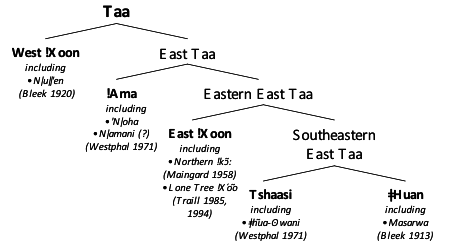The Taa language (aka ǃXoon/ǃXóõ; ISO 639-3 nmn) is the last vital language of the Tuu language family formerly called ʻSouthern Khoisanʼ. It is spoken by about 3000 people in Namibia and Botswana.

Internal linguistic classification of Taa. The split between ǃAma and Eastern East Taa corresponds to Traillʼs distinction between western and eastern dialects of ǃXóõ (Traill 1985). Adapted from: Naumann, Christfried. Forthcoming a. Towards a Genealogical Classification of Taa Dialects.

Geographical distribution of Taa dialects. Black circles indicate contemporary places with Taa speakers (DoBeS, 2004-2009), while white circles mark places attested in the past (previous literature, or birthplaces in our data). Adapted from: Naumann, Christfried. Forthcoming a. Towards a Genealogical Classification of Taa Dialects.
Taa (mostly represented by East ǃXoon) is famous for an extremely large phoneme inventory, i.e., it has been cited as the language with the largest consonant inventory (122 consonants, cf. Maddieson 2011) or the largest segment inventory (160 segments, cf. Mielke 2009). This is mainly due to the contrastive use of clicks (ʘ, ǀ, ǁ, ǃ, ǂ as basic types), uvular consonants, six series of stops related to laryngeal settings/airstream mechanisms (such as voiceless vs voiced), and the glottal modification in vowels (such as modal voice vs breathy voice). With an analysis that treats various syllable onsets as consonant clusters (such as [tχ] analyzed as /t+χ/ instead of the unit /tχ/, cf. Güldemann 2001, Nakagawa 2006), however, the consonant inventory can be reduced to about 88 segments.

Consonant phonemes of West ǃXoon (under cluster analysis), represented according to the proposed orthography. Source: Naumann, Christfried. Forthcoming. The phoneme inventory of Taa (West ǃXoon dialect). In Rainer Vossen & Wilfrid H.G. Haacke (eds.), Essays in Memory of Anthony Traill. Cologne: Köppe.
Taa matches the typological profile of ‘Khoisan’ languages of the area other than from the Khoe-Kwadi family in that 1) native lexical stems fit the phonotactic pattern C(C)V(C)V/C(C)VN, 2) there is comparatively little bound morphology, and 3) the basic constituent order is Subject – Predicate – Object (– Adjunct), whereby adjuncts are often marked by a default preposition called here multi-purpose oblique marker (Güldemann forthcoming a, b). An outstanding feature of Taa, however, is that nouns fall into agreement classes that are consistently indexed on dependent forms by means of segmental agreement markers (concords), i.e., i “class 1”, a(n) [a/ã] “classes 2i; 2ii”, e “classes 3i; 3ii”, u “class 4”, and nn [n]/ng [ŋ] “class 5” (i and ii refer to different tone classes). In the example given below, the transitive verb form gǀa-i “send (it)” cross-references class 1 of the following object noun màhrí “money“, and the oblique prepositionals kà~kì cross-reference classes 2ii~1 of áùtò “car”~ Kòbààbè “Gobabis”, respectively.
(Example) West ǃXoon (TWb080829-0201.wav, 511 s)
èé sí gǀá-í màhrí kà áùtò kì Kòbààbè
3ii IPFV send-1> money.1 OBL:2ii> car.2ii OBL:1> Gobabis.1
“She sends the money to Gobabis by car.”
Güldemann, Tom. 2001. Phonological Regularities of Consonant Systems across Khoisan Lineages. (University of Leipzig Papers on Africa: Languages and Literatures 16). Leipzig: Institut für Afrikanistik.
Güldemann, Tom & Rainer Voßen. Forthcoming. Syntax: !Xõo of Lone Tree. The Khoisan languages. (Routledge Language Family Series). London: Routledge.
Güldemann, Tom & Rainer Voßen. Forthcoming. Morphology: !Xõo of Lone Tree. The Khoisan languages. (Routledge Language Family Series). London: Routledge.
Maddieson, Ian. 2011. Consonant Inventories. In Matthew S. Dryer & Martin Haspelmath (eds.), The World Atlas of Language Structures Online. Max Planck Digital Library. http://wals.info/chapter/1 (24 September, 2012).
Mielke, Jeff. 2009. Segment Inventories. Language and Linguistics Compass 3(2). 700–718. doi:10.1111/j.1749-818X.2008.00117.x (24 September, 2012).
Nakagawa, Hiroshi. 2006. Aspects of the Phonetic and Phonological Structure of the Gǀui Language. Johannesburg: University of the Witwatersrand PhD diss.
Naumann, Christfried. Forthcoming. The Phoneme Inventory of Taa (West ǃXoon Dialect). In Rainer Vossen & Wilfrid H. G. Haacke (eds.), Essays in Memory of Anthony Traill. Cologne: Köppe.
Naumann, Christfried. Forthcoming. Towards a Genealogical Classification of Taa Dialects.


